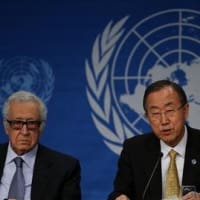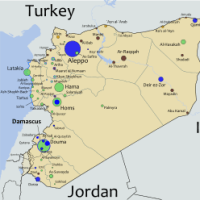


TOKYO — A long-simmering dispute between the United States and Japan over the fate of a Marine base on Okinawa seemed to have been resolved on Friday when the governor of Okinawa gave his approval to move the base to a remote area.
Prime Minister Shinzo Abe, left, met with the governor of Okinawa, Hirokazu Nakaima, in Tokyo on Wednesday.
The agreement would bolster efforts by the Pentagon to rebalance American military forces across the Asia-Pacific region and by the Japanese prime minister, Shinzo Abe, to raise his country’s strategic posture and check the growing military influence of China.
An official document approving a landfill on which much of the base would be built was stamped by the governor of Okinawa, Hirokazu Nakaima, and sent to the local branch of the Ministry of Defense, Kanako Shimada, a prefectural official, said on Friday.
Mr. Nakaima’s approval was a breakthrough after what had been longstanding opposition on Okinawa to the plan to move the Marine Corps’ Air Station Futenma, on the prefecture’s main island to the north of the island.
The original agreement to move the base, which is in a heavily populated area, was reached in 1996 after the gang rape of an Okinawan schoolgirl by American servicemen.
That fueled a local protest movement in Okinawa that advocated ousting the Marines from the island and even suggested that Okinawa declare its independence from Japan. Then there were concerns about the effects of building a new base in an environmentally sensitive area on the island’s coast.
The concerns delayed further progress on the agreement. A 2009 pledge by Yukio Hatoyama, who briefly served as prime minister, to move the base off Okinawa, perhaps to another part of Japan, confused the issue even more.
But since his return to the prime minister’s office a year ago, Mr. Abe had pressed Okinawan officials to finally give the go-ahead. In a meeting on Wednesday in Tokyo, Mr. Abe unveiled a set of measures to reduce the burden of the American bases on Okinawa, together with promises of financial support to the prefecture, Japan’s poorest.
That cleared the way for Mr. Nakaima’s approval of a landfill for the new base, Camp Schwab-Henoko Bay in the north.
For Mr. Abe, the approval comes at a time of increasing tensions with China that have led him to enhance security ties with the United States and to envision a bigger military role for Japan in the region.
Senior Defense Department officials said they viewed the agreement as critical to the Pentagon’s new strategy in the Asia-Pacific region.
The approximately 18,000 Marines now stationed on Okinawa will drop to about 10,000 once the new base is completed over the next decade.
During that time, facilities are to be built that would shift about 5,000 Marines to Guam, and plans are underway eventually to deploy about 2,500 Marines in Australia.
Those movements, Pentagon officials said, would create a more militarily useful distribution of Marines across the region, allowing them to be closer to a broader swath of territory as required for traditional security missions or disaster relief efforts.
Prolonged delays and uncertainty over the base in Okinawa had undermined the Obama administration’s plan for a strategic rebalancing in Asia.
A senior Pentagon official called the Okinawa agreement the “most significant” breakthrough in moving the American military to “a very operationally sustainable, distributed lay-down in the Pacific.”
“This sends a clear signal to the region that the alliance is strong, capable,” added the official, who requested anonymity because the agreement had not been formally announced.
The certainty of a continued Marine presence, according to Pentagon officials, demonstrates to other regional allies, as well as rivals, that the United States has the resolve to maintain its security presence despite its budget difficulties and fatigue from wars in the Middle East.
Another benefit, officials said, is that the United States and Japan could now focus on broader security issues.
With an agreement in place, “We can focus on the larger strategic issues on our plate,” another senior Defense Department official said.
Senior Pentagon officials acknowledged that additional hurdles could arise over the 10-year timetable required to replace Futenma with the new base at Henoko Bay, which is near a small existing installation called Camp Schwab. Staunch opposition to the base remains, and about 2,000 protesters gathered at the Okinawa prefecture offices on Friday after the agreement became known. Some pushed into the building’s lobby, occupying it, according to reports by the NHK television network.
Indications of a breakthrough surfaced earlier this week, when Mr. Abe reached a deal with Mr. Nakaima over environmental protection issues involving the new American base.
Officials in Washington credited a series of high-level meetings, including recent talks with the Japanese involving Vice President Joseph R. Biden Jr. and Defense Secretary Chuck Hagel.
Hiroko Tabuchi reported from Tokyo, and Thom Shanker from Washington.
<辺野古埋め立て>承認に市民ら抗議、県庁に千人なだれ込む
毎日新聞 12月27日(金)13時37分配信
<辺野古埋め立て>承認に市民ら抗議、県庁に千人なだれ込む
辺野古埋め立て承認に反対して沖縄県庁のロビーに座り込む市民=那覇市の沖縄県庁で2013年12月27日午後0時54分、和田大典撮影
那覇市の沖縄県庁前には27日正午ごろ、仲井真知事の埋め立て承認に抗議する市民ら約2000人(主催者発表)が集結。
庁舎を取り囲み、「屈しない」と書かれた赤いプラカードなどを掲げながら「辺野古埋め立てを許さないぞー」
「知事は県民を裏切るなー」とシュプレヒコールを上げた。
約1000人の市民らはその後、仲井真知事に説明を求めて県庁1階ロビーになだれ込み、座り込みを続けた。
【第一報】沖縄知事:辺野古埋め立て承認…防衛局に文書送付
4歳の長男を連れて参加した浦添市の主婦、比嘉佐和子さん(41)は「仲井真知事は不承認と言ってくれるかもしれないと一瞬でも信じた自分がばかだった。
お金で解決しようとする政府に怒りを感じるし、首相に『お金ください』とへらへらする知事もみっともない。
子供の将来のためにも、基地が少しでも減ってほしい」と話し、静かに怒りをたぎらせていた。【福永方人】




















※コメント投稿者のブログIDはブログ作成者のみに通知されます